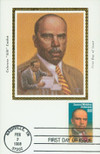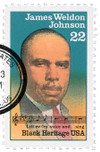
# 2371 - 1988 22c Black Heritage: James Weldon Johnson
U.S. #2371
1988 22¢ James Weldon Johnson
Black Heritage Series
- 11th stamp in Black Heritage Series
- Issued for 50th anniversary of Johnson’s death.
- Includes bars from the song Lift Ev’ry Voice and Sing
Stamp Category: Commemorative
Series: Black Heritage
Value: 22¢, first-class rate
First Day of Issue: February 2, 1988
First Day City: Nashville, Tennessee
Quantity Issued: 97,300,000
Printed by: American Bank Note Company
Printing Method: Photogravure
Format: Panes of 50 in sheets of 200
Perforations: 11
Why the stamp was issued: To honor poet, songwriter, diplomat, and activist James Weldon Johnson. Novelist Carl Van Vechten was the first to suggest a stamp honoring Johnson, in 1939, the year after he was killed in a car-train accident. This Black Heritage stamp was issued 50 years after his death.
About the stamp design: Thomas Blackshear created an acrylic portrait for this stamp based on several photos provided by the Johnson Collection of the Beinecke Rare Book and Manuscript Library at Yale University. Along with the portrait is two-and-a-half bars of the song Lift Ev’ry Voice and Sing.
First Day City: The First Day ceremony for this stamp was held at the Fisk Memorial Chapel at Fisk University in Nashville, Tennessee, where Johnson taught from 1930 until his death.
About the Black Heritage Series: The Black Heritage Series began on February 1, 1978, with the issue of the 13¢ Harriet Tubman stamp (US #1744). Since then, the USPS has issued a new stamp in the series every year. A number of them have even been released in February in recognition of Black History month. As of 2023, it was the USPS’s longest-running stamp series of all time.
History the stamp represents: James Weldon Johnson was born on June 17, 1871, in Jacksonville, Florida. A poet, songwriter, diplomat, and activist, he was the first African American executive secretary of the NAACP.
Johnson and his brother received their earliest education from their mother, a musician and school teacher. Johnson went on to attend Edwin M. Stanton School and Atlanta University. After graduating in 1894, Johnson returned to Florida, where he taught at his former school, Stanton, one of the largest African American schools in the city. He was made principal in 1906 and added ninth and tenth grades, to expand the school’s educational offerings. While working as a teacher, Johnson studied for the bar, and in 1897 he became the first African Americans admitted to the Florida Bar.
Also while teaching at Stanton in 1897, Johnson penned the poem, “Lift Every Voice and Sing,” to honor Booker T. Washington’s visit to the school. During his visit, 500 school children recited the poem on Abraham Lincoln’s birthday. The poem was later set to music and became known as the “Black National Anthem.” In 1901, Johnson and his brother moved to New York City where they worked together writing songs for a string of successful Broadway shows. Some of their hits included “Tell Me, Dusky Maiden”, “Nobody’s Looking but the Owl and the Moon,” and “Dem Bones.”
Johnson campaigned for Theodore Roosevelt in 1904. After Roosevelt became president, he made Johnson the US consul to Puerto Cabello, Venezuela from 1906 to 1908. He then served as consul to Nicaragua from 1909 to 1913. During his diplomatic work, Johnson wrote his most famous book, The Autobiography of an Ex-Colored Man, which he initially published anonymously due to his diplomatic work.
When he returned to New York, Johnson joined the Harlem Renaissance, an intellectual and cultural movement. He wrote poetry, produced a screenplay with his wife, and supported the work of others. Johnson eventually became one of the leading voices of the movement. Over the years he produced several books and poetry collections, including Fifty Years and Other Poems (1917), The Book of American Negro Poetry (1922), God’s Trombones: Seven Negro Sermons in Verse (1927), and Black Manhattan (1930.)
Johnson also became a leader in the civil rights movement. He participated in the campaign for the Dyer Anti-Lynching Bill and spoke at the 1919 National Conference on Lynching. In 1917, Johnson was made field secretary for the National Association for the Advancement of Colored People (NAACP). That summer, he organized a silent protest parade down New York City’s Fifth Avenue to bring attention to the large number of lynchings in the South.
Also in 1917, Johnson went to Memphis, Tennessee to investigate the lynching of Ell Persons. Johnson published his report on the lynching in the NAACP’s magazine, Crisis. Johnson also wrote about the corruption and violence in Haiti as a result of US occupation; the US eventually ended its occupation in 1934.
In 1920, Johnson became the first African American executive secretary of the NAACP. He worked to increase membership and opened many new chapters in the South. He also pushed the organization to launch legal challenges against the disenfranchisement of African Americans, such as poll taxes, literary tests, and white primaries.
Johnson resigned his post at the NAACP in 1930 to return to education. He taught creative literature at Fisk University in Nashville, Tennessee, a position created specifically for him. Johnson held that post until his death and taught literature and culture at New York University.
Johnson died on June 26, 1938, after his car was hit by a train. Some 2,000 people attended his Harlem funeral. Among the honors he received during and after his life include an NAACP Spingarn Medal, a W.E.B. Du Bois Prize for Negro Literature, and several honorary degrees, as well as schools and campus buildings named after him. Maine has designated his birthdate as James Weldon Johnson Annual Observance Day.
U.S. #2371
1988 22¢ James Weldon Johnson
Black Heritage Series
- 11th stamp in Black Heritage Series
- Issued for 50th anniversary of Johnson’s death.
- Includes bars from the song Lift Ev’ry Voice and Sing
Stamp Category: Commemorative
Series: Black Heritage
Value: 22¢, first-class rate
First Day of Issue: February 2, 1988
First Day City: Nashville, Tennessee
Quantity Issued: 97,300,000
Printed by: American Bank Note Company
Printing Method: Photogravure
Format: Panes of 50 in sheets of 200
Perforations: 11
Why the stamp was issued: To honor poet, songwriter, diplomat, and activist James Weldon Johnson. Novelist Carl Van Vechten was the first to suggest a stamp honoring Johnson, in 1939, the year after he was killed in a car-train accident. This Black Heritage stamp was issued 50 years after his death.
About the stamp design: Thomas Blackshear created an acrylic portrait for this stamp based on several photos provided by the Johnson Collection of the Beinecke Rare Book and Manuscript Library at Yale University. Along with the portrait is two-and-a-half bars of the song Lift Ev’ry Voice and Sing.
First Day City: The First Day ceremony for this stamp was held at the Fisk Memorial Chapel at Fisk University in Nashville, Tennessee, where Johnson taught from 1930 until his death.
About the Black Heritage Series: The Black Heritage Series began on February 1, 1978, with the issue of the 13¢ Harriet Tubman stamp (US #1744). Since then, the USPS has issued a new stamp in the series every year. A number of them have even been released in February in recognition of Black History month. As of 2023, it was the USPS’s longest-running stamp series of all time.
History the stamp represents: James Weldon Johnson was born on June 17, 1871, in Jacksonville, Florida. A poet, songwriter, diplomat, and activist, he was the first African American executive secretary of the NAACP.
Johnson and his brother received their earliest education from their mother, a musician and school teacher. Johnson went on to attend Edwin M. Stanton School and Atlanta University. After graduating in 1894, Johnson returned to Florida, where he taught at his former school, Stanton, one of the largest African American schools in the city. He was made principal in 1906 and added ninth and tenth grades, to expand the school’s educational offerings. While working as a teacher, Johnson studied for the bar, and in 1897 he became the first African Americans admitted to the Florida Bar.
Also while teaching at Stanton in 1897, Johnson penned the poem, “Lift Every Voice and Sing,” to honor Booker T. Washington’s visit to the school. During his visit, 500 school children recited the poem on Abraham Lincoln’s birthday. The poem was later set to music and became known as the “Black National Anthem.” In 1901, Johnson and his brother moved to New York City where they worked together writing songs for a string of successful Broadway shows. Some of their hits included “Tell Me, Dusky Maiden”, “Nobody’s Looking but the Owl and the Moon,” and “Dem Bones.”
Johnson campaigned for Theodore Roosevelt in 1904. After Roosevelt became president, he made Johnson the US consul to Puerto Cabello, Venezuela from 1906 to 1908. He then served as consul to Nicaragua from 1909 to 1913. During his diplomatic work, Johnson wrote his most famous book, The Autobiography of an Ex-Colored Man, which he initially published anonymously due to his diplomatic work.
When he returned to New York, Johnson joined the Harlem Renaissance, an intellectual and cultural movement. He wrote poetry, produced a screenplay with his wife, and supported the work of others. Johnson eventually became one of the leading voices of the movement. Over the years he produced several books and poetry collections, including Fifty Years and Other Poems (1917), The Book of American Negro Poetry (1922), God’s Trombones: Seven Negro Sermons in Verse (1927), and Black Manhattan (1930.)
Johnson also became a leader in the civil rights movement. He participated in the campaign for the Dyer Anti-Lynching Bill and spoke at the 1919 National Conference on Lynching. In 1917, Johnson was made field secretary for the National Association for the Advancement of Colored People (NAACP). That summer, he organized a silent protest parade down New York City’s Fifth Avenue to bring attention to the large number of lynchings in the South.
Also in 1917, Johnson went to Memphis, Tennessee to investigate the lynching of Ell Persons. Johnson published his report on the lynching in the NAACP’s magazine, Crisis. Johnson also wrote about the corruption and violence in Haiti as a result of US occupation; the US eventually ended its occupation in 1934.
In 1920, Johnson became the first African American executive secretary of the NAACP. He worked to increase membership and opened many new chapters in the South. He also pushed the organization to launch legal challenges against the disenfranchisement of African Americans, such as poll taxes, literary tests, and white primaries.
Johnson resigned his post at the NAACP in 1930 to return to education. He taught creative literature at Fisk University in Nashville, Tennessee, a position created specifically for him. Johnson held that post until his death and taught literature and culture at New York University.
Johnson died on June 26, 1938, after his car was hit by a train. Some 2,000 people attended his Harlem funeral. Among the honors he received during and after his life include an NAACP Spingarn Medal, a W.E.B. Du Bois Prize for Negro Literature, and several honorary degrees, as well as schools and campus buildings named after him. Maine has designated his birthdate as James Weldon Johnson Annual Observance Day.











